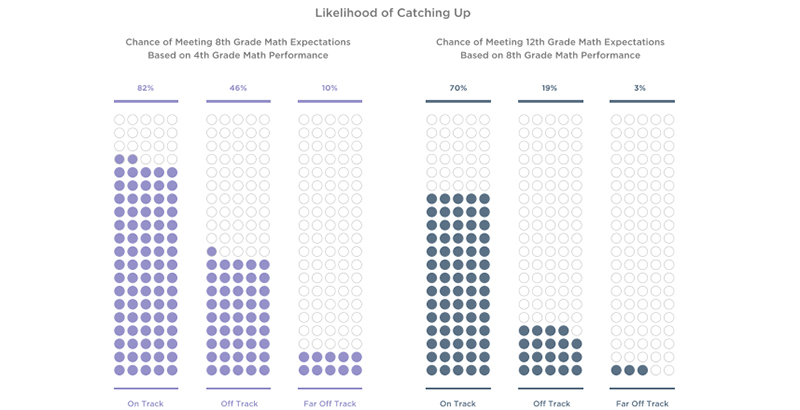Rose & Weisberg: Do Kids Fall Behind in Math Because There Isn’t Enough Grade-Level Material, or Because There’s Too Much? It’s Both

Walk into almost any classroom in America, and you’ll find at least some students who’ve fallen behind the academic standards for their grade — meaning they’re at risk of not learning everything they’ll need to be ready for college and the lives they want to lead. Helping these students get back on the path to grade-level proficiency is one of the most urgent challenges teachers face every day.
But as our organizations revealed in separate reports over the past year, it’s a challenge few schools and school systems have a real strategy to meet. By examining the quality and rigor of the work students are asked to do in class each day, our reports reached two conclusions — contradictory, at first glance — about the ways schools let struggling students down.
TNTP’s 2018 report The Opportunity Myth found that when students don’t meet grade-level standards, the problem usually isn’t that they tried and failed but that they were never given a real chance to try in the first place. The 4,000 students TNTP studied across five school systems spent hundreds of hours each year on work that was below their grade level. Those who started the year behind academically were the least likely to have grade-appropriate assignments — even when they were capable of succeeding on them — making it nearly impossible for them to ever catch up to their peers.
Then, this fall, New Classrooms Innovation Partners released The Iceberg Problem: How Assessment and Accountability Policies Cause Learning Gaps in Math to Persist Below the Surface … and What to Do About It, making a seemingly divergent argument. The paper highlights how an exclusive focus on grade-level material can hinder students’ progress in math, especially when they have unfinished learning from prior years. Instead, learning gaps accumulate and students graduate unable to access some of the fastest-growing and highest-paying jobs in the country because they lack advanced mathematical skills.
So which is it? Are kids being held back because of a lack of access to grade-level material, or because of an exclusive focus on grade-level material?
It’s both.
As educators, advocates, parents and policymakers consider what it will take to ensure that students are prepared for postsecondary success, it’s worth pointing out some important areas of agreement in our work and put forth some practical solutions.
High expectations are essential to every child’s education
Changing outcomes for students who fall behind grade level starts with a real belief that they can get back on track — and a willingness to make it the default expectation. School systems should set grade-level mastery as the goal for every student by the time he or she leaves high school.
The Opportunity Myth found clear connections between the academic expectations that teachers have for their students and their ultimate levels of achievement. In classrooms where teachers held higher expectations, for instance, students gained more than four months of additional learning. The relationships between high-quality academic resources and student outcomes were even stronger in classrooms where students started the year off behind.
These are important reminders of the systemic biases that continue to prevent all children — and especially students of color — from accessing rigorous, grade-level content.
Learning — especially mathematics — is cumulative
As part of a concerted research and development effort in middle-grade math, New Classrooms has investigated the standards and underlying concepts reflected at each grade level, explored the relationships among those concepts and reviewed tens of thousands of lessons teaching them. The research demonstrated that a student’s ability to learn, apply and master key math concepts requires predecessor knowledge. Without it, chances of success diminish.
Consider the ability to multiply and divide large numbers, a skill that should typically be mastered by fourth grade, if not earlier. If students make it to middle school without a fluent understanding of how to perform these operations, they will struggle to fully grasp how to evaluate algebraic expressions in sixth grade, which can make it even harder to master linear functions in eighth grade. This dramatic accumulation of unfinished learning may not be evident above the surface when reviewing the results on state assessments, but it prevents students from accessing more advanced mathematical concepts required to graduate ready for college or career.
Educators need better support
Helping students reach grade-level proficiency is about more than just belief. It also takes specific instructional techniques and innovative approaches that can make challenging material accessible to students at a wide range of academic levels without watering it down. Teachers deserve coaching and support at every level of their careers — starting with their pre-service training — that helps them learn and practice these skills. But most aren’t getting that support, leaving them caught between not assigning any grade-level work and cramming in low-quality test preparation in advance of the state exam — neither of which helps students get any closer to real grade-level mastery.
Measuring growth matters
If today’s state assessments were structured to more accurately measure student growth, perhaps schools and teachers could be more strategic in how they address this challenge. But as The Iceberg Problem points out, state assessments in math focus almost exclusively on grade-level standards, meaning any gains made on pre- or post-grade skills will likely not be reflected on statewide tests that serve as the basis for accountability.
We must not give an inch on the notion that all students need access to a rigorous, high-quality education that prepares them for college and career, nor retreat from the progress made over the past 20 years to incorporate accountability into our education system.
At the same time, we must recognize that when it comes to middle-grade math, a strategic mix of pre-, on- and in some cases post-grade skills may be more helpful in preparing some students for college and career readiness than would an exclusive adherence to grade-level material.
Successfully addressing students’ unfinished learning from prior years while maintaining high academic expectations for all students is a tall order for even the most skilled teachers. It is incumbent upon policymakers and administrators to develop strategies and approaches that thoughtfully reconcile these competing tensions, rather than simply expecting teachers to resolve them on their own.
Joel Rose is CEO of New Classrooms Innovation Partners, a national nonprofit that develops and advocates for innovative, student-centered learning models that redesign the classroom experience in order to better meet the strengths and needs of each student.
Daniel Weisberg is the CEO of TNTP, a national nonprofit that helps school systems provide excellent teachers and effective teaching in every classroom.
Get stories like these delivered straight to your inbox. Sign up for The 74 Newsletter

;)
